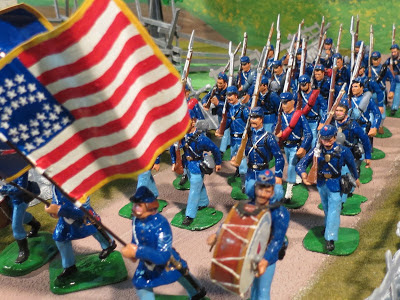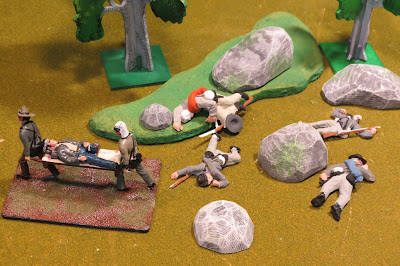This post is about me, and this post is about you. This is also a post about our imagination.
When I was a little kid, two important things happened that changed my life.
One was a trip to Gettysburg with my father and brother...
and the other was a letter from famous Civil War writer Bruce Catton.
In his letter he said that he'd be sending me a copy of his new book "This Hallowed Ground." Every day after school I'd ask my mother if my book had come. Finally the day came and my book arrived. It was beautiful, and I constantly looked at the pictures and read the captions, often while I was playing with my toy Civil War soldiers.
(Bruce Catton with his toy soldiers)
When I was a little kid I was sick a lot and missed school frequently.
My mother told me about a Scottish writer and Poet named Robert Louis Stevenson, who was my age (ten) during the Civil War. Like me, Robert was sick a lot. And one of the things that he did while lying in bed was to use his imagination and play with his toy soldiers.
Many years later he wrote a poem about those adventures...
The Land of Counterpane
by Robert Louis Stevenson
by Robert Louis Stevenson
| When I was sick and lay a-bed, I had two pillows at my head, And all my toys beside me lay, To keep me happy all the day. And sometimes for an hour or so I watched my leaden soldiers go, With different uniforms and drills, Among the bed-clothes, through the hills; And sometimes sent my ships in fleets All up and down among the sheets; Or brought my trees and houses out, And planted cities all about. I was the giant great and still That sits upon the pillow-hill, And sees before him, dale and plain, The pleasant land of counterpane. |
Here I am, sick at home, playing with soldiers and reading the book that Mr. Catton sent me.
One of the things that I really enjoyed about the book was that Mr. Catton often used toy soldiers to illustrate what he was talking about. I found these pictures absolutely fascinating...I still do.
If you zoom in on the picture above you'll see that I have a cannon identical to the one in the picture.
I had been playing with toy soldiers since I was about five-years-old, and when I saw how they could be used to tell a story I became even more excited about setting them up to represent different battles or important moments in those battles.
This blog post is intended to spark your imagination on how you can use your soldiers to tell those important stories. I find that doing this and taking lots of photos for this blog caused me to enjoy the toy soldier hobby even more, and I hope that what I do here helps you to see just how important imagination can be...yours, as well as mine.
So here is my latest effort - a small portion of the second day of the three-day Battle of Gettysburg which was fought in early July of 1863. The action takes place in the area of a huge boulder formation called "Devil's Den" and a hill called "Little Round Top."
The action here starts as the Confederates, commanded by General Robert E. Lee have taken position of Devil's Den and are firing upon the Union soldiers on Little Round Top. The Union soldiers were commanded by General George Gordon Meade.
Here comes the battle, a chance for you to use your imagination as you look at the pictures, which you can click on to make them larger.
Here's the part of the battlefield we'll be looking at; you might want to zoom in on this photo.
Little Round Top is the hill toward the top of the picture. You can see the boulders of Devils Den peeking through the trees to the right. At the bottom of the picture is Oak Hill where the Confederates have seven breech-loading Whitworth cannons which could shoot over five miles!
In the distance in the upper right of the photo is the hill named Round Top.
Round Top was higher than its little brother but it was too covered with trees to be used by the Union cannons; so it was unoccupied for most of the three-day battle.
In a little white-washed house that was owned by Mrs. Leister, Union General George Gordon Meade set up his headquarters.
Meade was a career army man and a very skilled general, but he was also known for having a bad temper and was often referred to by his men as a "goggle-eyed old snapping turtle." Despite that he was more than a match for his opponent...
Robert E. Lee (on the right). Lee was also a very skilled general and led his Army of Northern Virginia to many victories.
The first two days of the battle had gone pretty well for the Confederates in areas like the Wheatfield and the Peach Orchard...that's the group of small trees in the foreground.
One of the main Union regiments fighting in the Peach Orchard was the 3rd Michigan...you can see my post about them here.
By the middle of the day the Confederates had occupied the Devil's Den, which was a very strong position.
The Confederates in Devil's Den are firing at the Union troops in front of Little Round Top.
There were also artillery duels going on between the Union and Confederate cannons.
Fortunately for the Union forces, Meade's chief engineer - brigadier general G.K. Warren was on top of the hill and realized the danger.
Thinking fast, he went down the back of the hill and found the troops of general Strong Vincent marching by and ordered them to the top of the hill.
Just in the nick of time those Union soldiers took up position on Little Round top and started firing at the Confederates.
Warren also managed to get some cannons up in that very strong and commanding position.
For hours the two sides exchanged fire.
The rebels were using the Devil's Den as a natural fortification and were delivering accurate fire against the yankees on Little Round Top.
Finally, to break the stalemate, the Confederates made a charge toward the lightly defended flank of the hill.
The Confederates were getting closer and closer.
The Confederate attack was broken, with many rebels killed or wounded.
The following day (July 3) Lee made his final desperate charge against the Union line, but his men were driven back in defeat.
General Lee suffered great losses at the Battle of Gettysburg, and following the battle he retreated back in to Virginia; he would never lead his army on an invasion again.
Remember at the beginning of this post when I said that the visit to Gettysburg
changed my life?
Well here I am, fifty-five years later...
a Park Ranger who got to work at the Antietam National Battlefield
for over eight years.
That's where toy soldiers took me. Who knows where your imagination and your enjoyment toy soldiers will take you.
Soldier on!
Mannie
p.s.
Of the 200 soldiers on my battle table, all but 33 were made and painted by me.
I also made the rocks and ridges, the hills, the larger tents, and all of the trees. You can see a video of me making the soldiers here, and making the trees here.
You too, can find ways to make your own scenery...just use your imagination.
Also...
I'm no Robert Louis Stevenson or a Bruce Catton, but I did write and illustrate a coloring book. It tells, in rhyme, the story of the battle of Antietam.
I have only a few left, but if you have your parent contact me, I'll be happy to send you one, especially if they include a picture of one of your toy soldier battles!
My email address is: museumofamerica@myactv.net.














































9 comments:
Inspiring post, beautifully illustrated with the figures and photos, just like your Bruce Catton Book. Great to have seen your childhood photos too - I really like the Land of Counterpane poem. I hope you inspire a new generation of Civil War toy soldier fans!
What a cracking looking battle - well done sir !
Great post. I didn't know there was an illustrated young person's edition, would have loved it, I was big on illustrated books with pictures of battles etc. .
Thank you Mannie.
A wonderful story, from so many approaches, Mannie. The telling of the battle, from your recreation, is a powerful teaching tool.
I only recently encountered Ralph Peters' excellent 'Battle Hymn Cycle' historical fiction series, which deals with the war in the east. I had read nearly all of his modern military books (fiction and personal recollections alike), years ago. Then, a good friend loaned me a copy of 'Hell or Richmond', and I was off. Hi 'Cain At Gettysburg' relates the very fight you have related so well.
It is a joyous thing, to be able to share your life with toy soldiers. Thank you.
Hi Mannie... a great post. I'll be showing it to my youngest lad when he gets home from school. All my kids play with toy soldiers in one form or another, so I'm very lucky. Sadly we don't treasure our battlefields here in England, so there is little chance of them becoming a battlefield ranger, but things may change.
best regards
Mike
This is a fantastic story. And I love your setup.
Cheers!
-John
A simply brilliant post!
What a gent. I hope you wrote back and thanked him.
Post a Comment